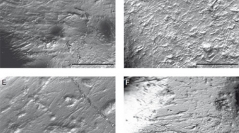

 Geodiversitas
31 (4) - Pages 865-878
Geodiversitas
31 (4) - Pages 865-878This study aims to characterize the feeding habits of the first European colobines, Mesopithecus (late Miocene), through the analysis of its molar microwear pattern. Fifty-seven adult individuals of Mesopithecus (from Greece and Bulgaria) are compared to 162 wild-shot specimens representing nine modern species of African and Asian cercopithecids. Through the combination of a principal component analysis and analyses of variances, Mesopithecus displays significant differences with its extant colobine relatives. Actually, there is no significant difference between the Mesopithecus samples and Chlorocebus aethiops and Papio hamadryas. An intra-specific test dedicated to Mesopithecus pentelicus reveals no difference between the Bulgarian and the Greek samples. To sum up, the species of Mesopithecus were not leaf eaters like their present-day colobine relatives. Considering its wide paleogeographic range, its post-cranial anatomy, the paleoenvironmental data, and the present dietary reconstruction as a whole, the species of Mesopithecus can be depicted as semi-terrestrial monkeys opportunists in term of feeding preferences.
Mammalia, Primates, Cercopithecoids, Neogene, Europe, diet, ecology.